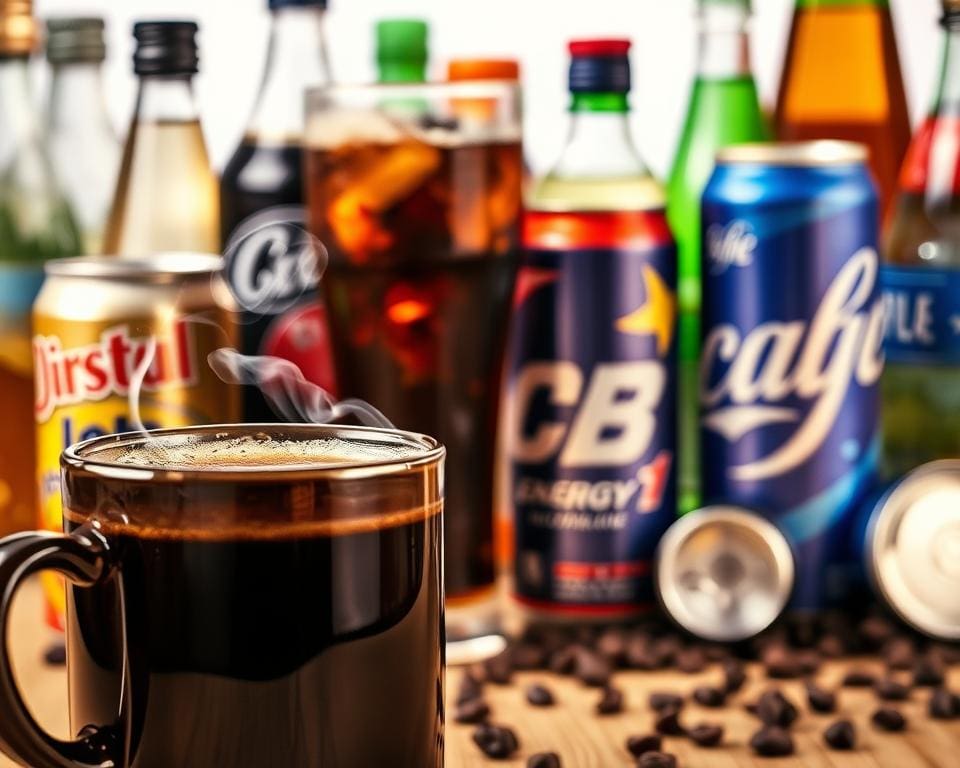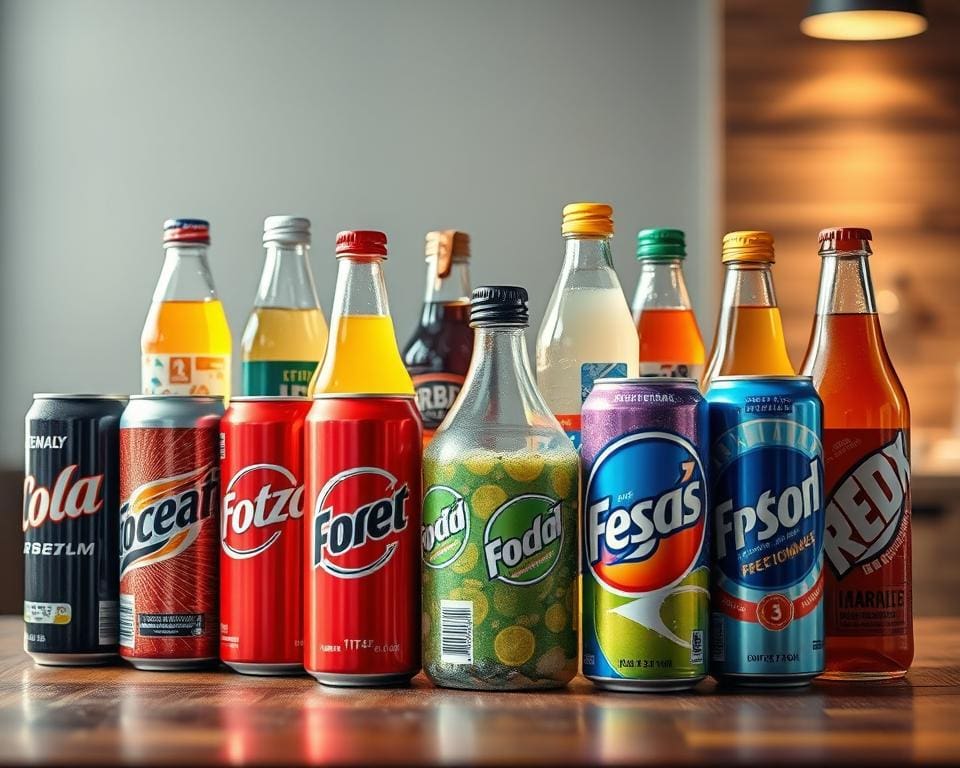The rise in popularity of caffeinated soft drinks has sparked curiosity among consumers in the UK about which soft drinks have caffeine and their associated benefits. Caffeine, a natural stimulant, is increasingly present in various beverages with caffeine, providing an energising boost that many people seek throughout their day. As interest in these beverages continues to grow, this article will delve into the notable options available, their caffeine content, and the health implications worth considering.
Understanding Caffeine in Beverages
Caffeine serves as a powerful stimulant, known to enhance alertness, improve concentration, and reduce feelings of fatigue. This makes it a popular choice in various types of beverages, including soft drinks, coffee, and tea. Consumers often seek to understand caffeine as it plays a significant role in daily routines.
The caffeine content in soft drinks varies widely, influenced by factors such as brand and formulation. Many people may not realise that the caffeine levels in these beverages differ significantly from those found in traditional coffee or tea. For instance, while a standard cup of coffee may contain around 95mg of caffeine, a can of cola could offer only about 30mg. This discrepancy is crucial for individuals aiming to monitor their intake.
Understanding caffeine helps consumers make informed choices suitable for their daily needs. Those who depend on caffeine in beverages for a boost should be aware of their options. Different drinks can provide varying amounts of caffeine, which affects not only consumption habits but also overall health. Being conscious of caffeine levels can lead to a more balanced approach to hydration and energy maintenance.

Which Soft Drinks Have Caffeine
Caffeine plays a significant role in the world of soft drinks. This natural stimulant is primarily found in plants such as coffee beans, tea leaves, and cocoa beans, which enhances both flavour and functionality in soft drinks containing caffeine. For many, these caffeinated beverages are synonymous with boosted energy levels and improved alertness, making them a popular choice for those seeking a pick-me-up.
Definition and Importance of Caffeine
At its core, caffeine is a central nervous system stimulant that temporarily wards off drowsiness and restores alertness. When consumed, it quickly enters the bloodstream and affects the brain, thus explaining its prominence in soft drinks. Caffeinated beverages not only enhance taste but also provide a quick energy boost, vital for many consumers during busy days or long nights.
Health Implications of Caffeine Consumption
The health implications of caffeine are a subject of ongoing research. Regular consumption of soft drinks containing caffeine can contribute to improved focus and performance in cognitive tasks. Yet, it is essential to be aware of potential drawbacks. Excessive intake may lead to anxiety, sleep disturbances, and increased heart rate. Striking a balance is crucial, allowing individuals to enjoy their favourite caffeinated beverages while being mindful of the associated health implications of caffeine.
Popular Caffeinated Sodas
In the vibrant landscape of fizzy drinks with caffeine, various brands have captivated consumers with their unique flavour profiles and innovative marketing strategies. Understanding the allure of these popular caffeinated sodas requires a glimpse into the flavours that resonate with people across the UK. Consumers often gravitate towards specific brands based on their taste preferences, making the soda with caffeine market both diverse and exciting.
Comparing Flavours and Preferences
The richness of flavours in popular caffeinated sodas contributes significantly to consumer choices.
- Coca-Cola: A classic favourite, its blend of sweetness and caramel notes creates a refreshing experience.
- Pepsi: Known for its slightly sweeter taste compared to its rival, Pepsi appeals to those seeking a bolder flavour.
- Dr Pepper: With a unique blend of 23 flavours, this soda offers a distinct combination that intrigues many.
Many consumers find themselves favouring specific brands based not just on taste but also on cultural associations and advertising campaigns. Each soda with caffeine carries its own story and vibe, influencing how they resonate with different audiences.
Brand Highlights and Unique Offerings
In addition to established brands, several niche companies have emerged, bringing creative options to the market.
- Fanta: With a fruity range that includes orange and strawberry, Fanta gives a playful twist to the traditional caffeinated sodas.
- Irn-Bru: A Scottish favourite, known for its distinctive taste and bright orange colour, captures a dedicated following.
- Mexican Coke: Favoured for its use of cane sugar, this variant offers a nostalgic taste that appeals to many.
With so many options in fizzy drinks with caffeine, the exploration of flavours continues to excite consumers. Each brand provides an opportunity for discovery and preference, making the market highly competitive and captivating.
Caffeinated Soft Drinks Around the World
The landscape of caffeinated soft drinks varies tremendously across borders, reflecting cultural preferences and consumption habits. In Asia, energy drinks reign supreme, with brands like Red Bull and Monster leading the charge, appealing to younger generations seeking a quick energy boost. These beverages with caffeine worldwide are not just functional but have become a lifestyle choice.
Conversely, traditional sodas dominate the global soft drink market in America and Europe. Iconic brands such as Coca-Cola and Pepsi continue to evolve, incorporating caffeine in ways that cater to local tastes. Their flavours resonate with consumers, bridging nostalgia and modern preferences.
Cultural attitudes toward caffeine consumption significantly influence these trends. Some nations embrace caffeine as a vital aspect of daily life, while others approach it with caution. Understanding these nuances provides insight into the dynamic nature of caffeinated soft drinks globally.
The Science Behind Caffeine Content in Soft Drinks
Understanding the science behind caffeine content in soft drinks is essential for those who enjoy these beverages. Measuring caffeine accurately allows both consumers and manufacturers to gauge the amount found in various drinks. Different techniques have been developed over the years to determine caffeine levels, ensuring that information on labels is reliable.
How Caffeine is Measured in Beverages
Caffeine content in soft drinks can be determined using several methods. Common techniques include high-performance liquid chromatography (HPLC), which separates components in a mixture for precise analysis. Another method, spectrophotometry, utilises light absorption characteristics to quantify caffeine. These methods provide vital data about the caffeine content, enabling consumers to make informed choices about their beverages.
Factors Influencing Caffeine Levels
Several factors influence caffeine levels in soft drinks. These include:
- Formulation: Different brands may use varying recipes that affect caffeine concentration.
- Serving size: Larger servings might contain more caffeine compared to standard servings.
- Preparation methods: The way a beverage is produced, such as whether it is brewed or carbonated, can impact caffeine levels.
Being aware of these factors can help consumers manage their caffeine intake and make better beverage choices according to their preferences.
Carbonated Drinks with Caffeine: A Growing Trend
The market for carbonated drinks with caffeine is witnessing a remarkable evolution. Sales data indicates a significant surge in popularity, matching the dynamic pulse of consumer preferences. A growing number of individuals seek fizzy beverages that not only quench their thirst but also provide an energising boost. This combination aligns perfectly with current soft drink trends, reflecting an innovative approach in the beverage industry.
Emerging brands are stepping into the spotlight, offering unique flavours that differentiate them from traditional options. From fruity blends to exotic spices, these inventive combinations cater to adventurous taste buds. The appeal of carbonated drinks with caffeine continues to draw consumers, creating a vibrant landscape enriched with diversity and creativity.
Market research highlights the growth trends in caffeinated beverages, indicating that consumers appreciate the fusion of carbonation and caffeine. This attractively effervescent offering meets the modern demand for beverages that invigorate both body and spirit. As the landscape of soft drinks transforms, it becomes clear that the future holds exciting possibilities for carbonated drinks infused with caffeine.
Alternative Caffeinated Beverages
The beverage market is witnessing a significant shift as consumers become increasingly health-conscious and seek out alternative caffeinated beverages. This growing interest has led to a noticeable energy drinks competition, where traditional soft drinks face opposition from products marketed as energy boosters.
Energy Drinks vs. Soft Drinks
Energy drinks often contain higher caffeine levels compared to traditional soft drinks, catering to consumers looking for a quick energy fix. Common ingredients include taurine and B vitamins, which enhance the energising effect. In contrast, soft drinks usually feature less caffeine, with sugar being a primary ingredient, posing concerns over excessive sugar intake. The choice between these two types of beverages often depends on personal preferences and lifestyle choices.
Natural Sources of Caffeine in Soft Drink Alternatives
The trend towards healthier options has prompted brands to explore natural caffeine sources within alternative beverages. Sodas made from tea or yerba mate now provide a more wholesome caffeine boost while often maintaining lower sugar levels. This approach satisfies consumers’ desire for a fulfilling drink experience without compromising their health. As the market evolves, the options for alternative caffeinated beverages will likely expand, offering shoppers an array of flavours and health benefits.
Consumer Awareness and Label Reading
Understanding caffeine content in soft drinks is essential for making informed choices about your beverage consumption. With numerous brands on the market, it’s crucial for consumers to enhance their consumer awareness on caffeine by effectively reading beverage labels. Many times, the amount of caffeine listed can vary significantly depending on the serving size, making it vital to examine these details closely.
When diving into soft drinks, note that a standard can might not represent a full serving when consumed in one sitting. This discrepancy can drastically impact your total caffeine intake. Therefore, knowing how to interpret servings and caffeine levels will empower you to moderate your consumption wisely. The implications of caffeine consumption are wide-ranging, influencing your well-being and energy levels throughout the day.
By promoting an understanding of caffeine content through mindful label reading, you can take control of what you ingest. This awareness not only helps in maintaining a balanced diet but also fosters a healthier lifestyle. As the trend towards caffeinated beverages continues to grow, being informed is more vital than ever for savvy consumers navigating the soft drink landscape.









